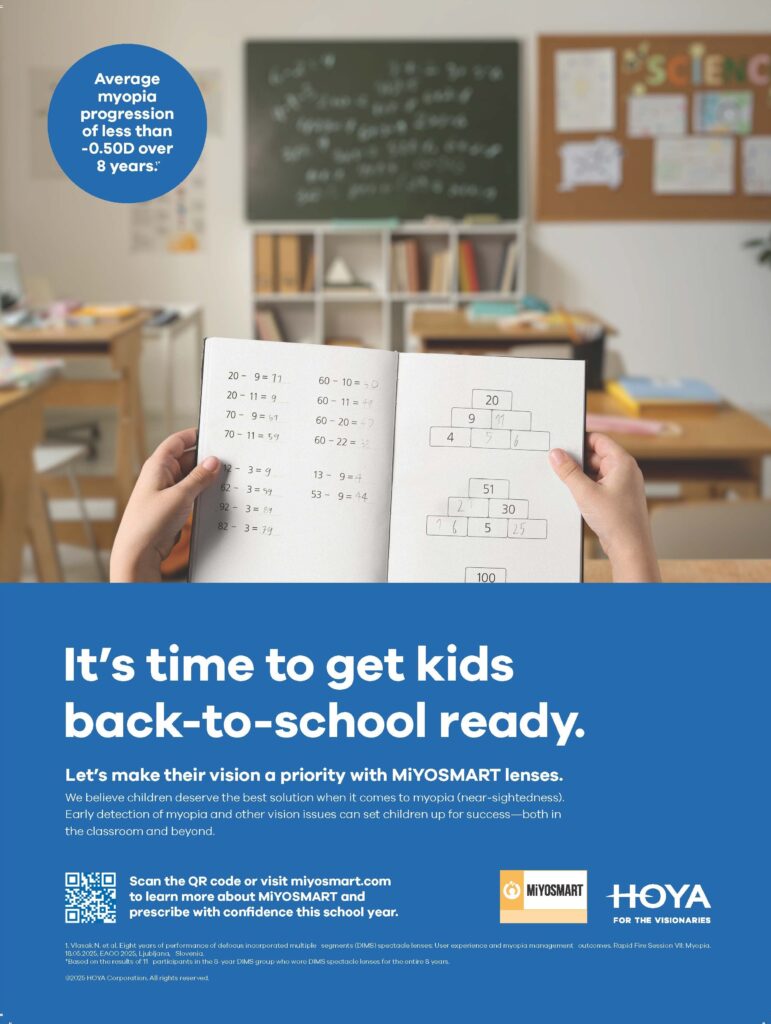
hoya vision
As September approaches and families across British Columbia begin preparing for the return to school, it’s easy to get swept up in the usual back-to-school rituals—new shoes, sharpened pencils, fresh lunchboxes, and packed calendars. But there’s one essential item that often gets overlooked on the checklist: a comprehensive eye exam.
Whether your child is entering kindergarten or heading into high school, good vision is foundational to success—both in the classroom and beyond. For Eye Care Professionals (ECPs), the back-to-school season is not just a reminder to ramp up clinical readiness, but a meaningful opportunity to educate parents, support families, and empower children to start the school year with confidence and clarity.
Vision and Learning: The Critical Connection
It’s estimated that up to 80% of classroom learning is visual¹. From reading the whiteboard and tracking words on a page to participating in sports and navigating digital tools, a child’s ability to see clearly and comfortably can dramatically influence their academic performance and social development.
But here’s the challenge: many children don’t realize they have a vision problem. They assume that what they see is what everyone sees. They may struggle with blurry vision, frequent headaches, difficulty concentrating, or trouble with hand-eye coordination—and yet, it often goes unrecognized. Parents may attribute these symptoms to behavioural issues, attention deficits, or simply tiredness. In many cases, the root cause is an undiagnosed visual issue.
To better understand how myopia (nearsightedness) affects children’s vision, explore the MiYOSMART Myopia Simulator—an interactive tool for parents and ECPs that shows how a child with myopia perceives the world around them.
The good news? Annual comprehensive eye exams can catch these concerns early—and in many cases, provide simple, effective solutions that can make a world of difference.
Why August is the Smart Time to Book
In British Columbia, the school year begins right after Labour Day, and August quickly becomes one of the busiest months for families and clinics alike. Booking an eye exam early gives parents peace of mind, ensures that any necessary eyewear is ready before the first bell rings, and helps avoid last-minute rushes when appointment availability may be limited.
Many families may not be aware that Medical Services Plan (MSP) in British Columbia covers one full eye exam per year for children and youth aged 0–18². That makes it both accessible and cost-effective to prioritize vision care as part of back-to-school planning.
For ECPs, now is the time to remind your patients—especially those with school-aged children—of this benefit. Outreach can take many forms: digital reminders, posters in your office, community newsletter submissions, or themed back-to-school promotions.
Myopia on the Rise: A Growing Concern for Children’s Eyes
One of the biggest trends in pediatric vision care is the increasing prevalence of myopia. Research shows that rates of myopia have doubled over the past two decades, and this condition is now affecting children at younger ages³. Left unmanaged, myopia can progress rapidly and increase the risk of more serious eye health issues in adulthood, including retinal detachment and glaucoma⁴.
There is hope—MiYOSMART, from HOYA Vision Care, a global leader in optical innovation, is an advanced lens technology clinically proven to help slow the progression of myopia in children5, all while providing clear and comfortable vision. As of 2025, this clinically proven lens is now available in photochromic, polarized, and Full Control options for additional UV and Blue light protection, making it even more appealing to active children and cautious parents alike6.
ECPs should consider incorporating myopia screening into all pediatric eye exams and having an action plan ready to discuss with families. With clear explanations and flexible lens solutions, it becomes easier to guide families toward long-term visual wellness.
How ECPs Can Prepare for Back-to-School Season
August and September can be the busiest time of year for many optical clinics. A few key strategies can help you stay organized and optimize care delivery during this peak period:
- Get the word out early. Start promoting back-to-school eye exams in late July or early August through your website, social media, email blasts, and in-office signage.
- Offer flexible scheduling. Consider opening up evening or weekend slots for busy families. Online booking tools and family-friendly appointment blocks can ease the process.
- Showcase kid-friendly frames. Today’s children want style, comfort, and durability. Parents want quality and protection. Make it easy by displaying lightweight, flexible, and stylish frame options in a dedicated “kids corner.”
- Educate parents. Many are unaware that digital screens can contribute to visual fatigue, dryness, and eye strain. Consider recommending anti-fatigue lenses, blue light control coatings, and encourage regular breaks using the 20-20-20 rule.
- Leverage your loyalty programs. If you offer family multi-pair promotions, back-to-school second-pair discounts, or extended warranties, now’s the time to highlight them. These can be powerful incentives for families purchasing glasses for more than one child—or upgrading their own.
The Parent’s Role: What to Watch For
For families reading this, here are a few signs that may indicate your child is struggling with his or her vision:
- Squinting or sitting very close to screens
- Holding books unusually close or far
- Covering one eye when reading
- Complaining of headaches or tired eyes
- Trouble concentrating, especially during reading or homework
Even if none of these signs are present, annual eye exams are essential. Children’s vision can change rapidly, and early detection ensures the best outcomes—not just for eyesight, but for overall development and confidence.
A Clear Vision for a Bright School Year
Back-to-school is about more than supplies—it’s about setting children up for success. Vision is at the heart of how children learn, connect, and explore the world around them. And for ECPs, this season is a powerful opportunity to show up for your community and support lifelong eye health from the very beginning.
So, before the backpacks are zipped and the school buses roll out, make sure every child has a clear path forward starting with their vision.
References
- Canadian Association of Optometrists. (2018). Meeting the eye health and vision care needs of Canadians: A workforce analysis. Retrieved from https://opto.ca/sites/default/files/resources/documents/workforce_analysis_report_april_2018_en.pdf
- Government of British Columbia. (2022). Health benefits: Medical Services Plan (MSP) coverage for children. Retrieved from https://www2.gov.bc.ca/gov/content/health/health-drug-coverage/msp/bc-residents/benefits/services-covered-by-msp
- World Health Organization. (2019). The Impact of Myopia and High Myopia. Retrieved from https://www.who.int/publications/i/item/9789241516570
- Flitcroft, D. I., He, M., Jonas, J. B., Jong, M., Naidoo, K. S., Ohno-Matsui, K., Rahi, J., Resnikoff, S., Vitale, S., & Yannuzzi, L. A. (2019). Defining and Classifying Myopia: A Proposed Set of Standards for Clinical and Epidemiologic Studies. Investigative Ophthalmology & Visual Science, 60(3), M20–M30. Retrieved from https://www.ncbi.nlm.nih.gov/pmc/articles/PMC6735818
- HOYA Vision Care. (n.d.). Evidence‑Based Treatment with MiYOSMART (DIMS) Spectacle Lenses. Retrieved from HOYA Vision website: research and clinical study summaries showing a 60% reduction in myopia progression over two years and sustained efficacy through six to eight years.
https://www.hoyavision.com/for-spectacle-wearers/miyosmart2/evidence-based-treatment/ - HOYA Vision Care. (2024). MiYOSMART Clinical Summary – 6-Year Follow-up Study. Internal publication and data on file.
HOYA Vision. (2024). MiYOSMART Myopia Simulator. Retrieved from https://www.hoyavision.com/en-ca/for-eyeglass-wearer/miyosmart2/miyosmart-myopia-simulator/#myopiasimulator


